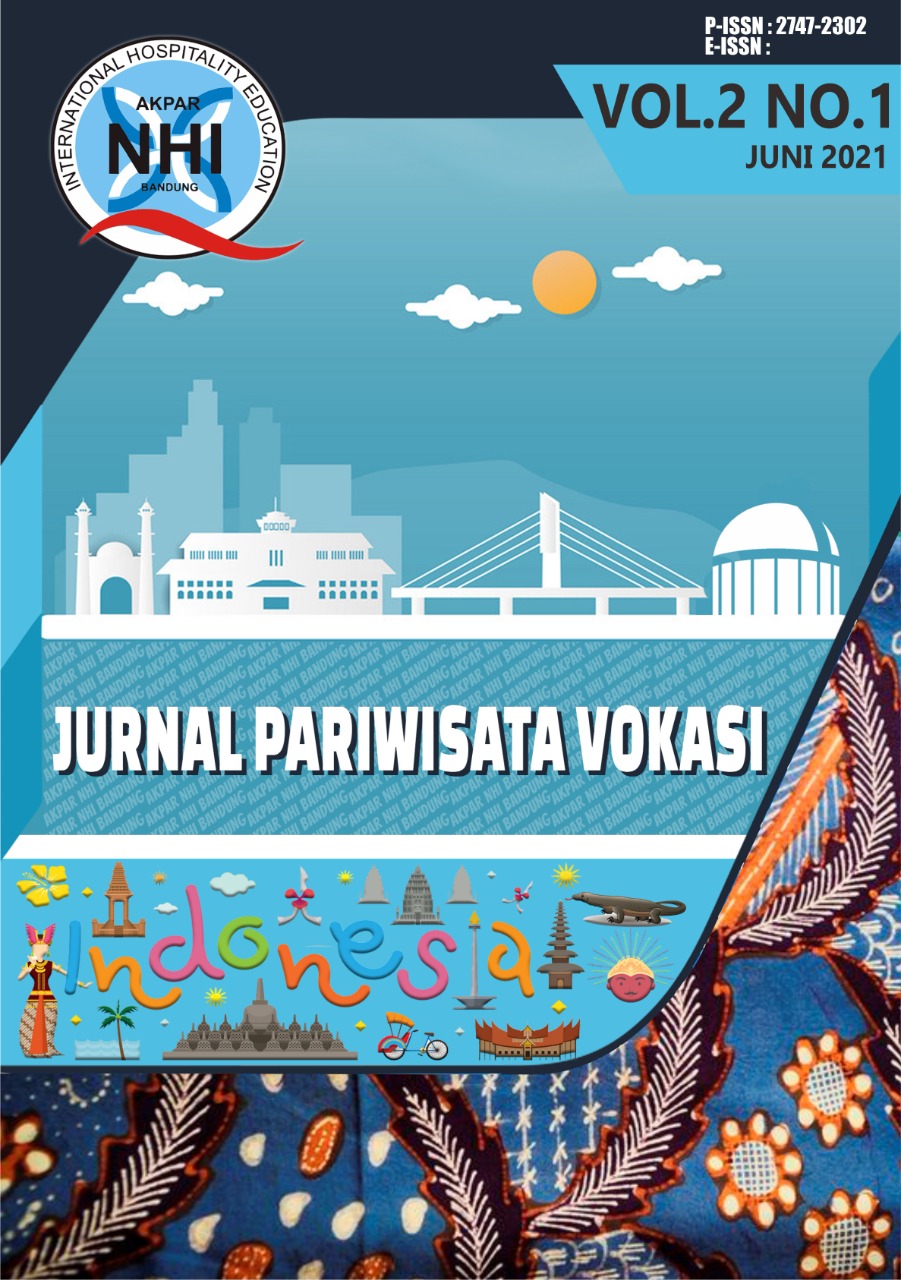PENGGUNAAN DAUN KANGKUNG SEBAGAI PENGGANTI RUMPUT LAUT DALAM PEMBUATAN NORI
Abstrak
Penelitian ini bertujuan Untuk mengetahui perbedaan citarasa, kandungan gizi, dan biaya produksi antara nori yang terbuat dari daun kangkung dengan nori rumput laut yang akan menghasilkan hasil uji organoleptic yang terbaik dan banyak disukai panelis dan juga sebagai penganekaragaman pangan berbahan dasar daun kangkong. Metode pengumpulan yang dilakukan adalah metode eksperimen. Teknik pengumpulan data yang dilakukan yaitu dengan cara eksperimen produk, penyebaran kuesioner, observasi. Sedangkan teknik analisis data dengan menggunakan skala hedonik. Berdasarkan hasil penelitian dapat diketahui Panelis profesional menyatakan jika nori daun kangkung memilki hasil yang lebih baik dibandingkan dengan nori rumput laut. hal ini berdasarkan pada beberapa komentar panelis profesional yang menyatakan bahwa nori rumput laut memilki aroma yang sedikit amis dan rasanya mudah hilang jika dimasukan kedalam mulut. Sedangkan menurut panelis konsumen menyatakanan bahwa nori rumput laut lebih enak dibandingkan dengan nori daun kangkung. Hal ini berdasarkan komentar panelis konsumen yang menyatakan bahwa nori daun kangkung memiliki tekstur yang sedikit berkerut dan warna yang sedikit lebih coklat.; andungan gizi dari segi kalori, nori daun kangkung lebih tinggi dibandingkan dengan nori rumput laut. Sedangkan dari segi protein nori rumput laut lebih tinggi dibandingkan dengan nori daun kangkung. Dari segi lemak nori daun kangkong lebih rendah dibandingkan dengan nori rumput laut dan dari segi karbohidrat nori daun kangkong lebih rendah dibanding dengan nori rumput laut. Maka dapat disimpulkan bahwa gizi nori daun kangkung lebih baik daripada nori rumput laut.; dan Nori daun kangkung memiliki biaya produksi yang lebih rendah jika dibandingkan dengan nori rumput laut yaitu Rp.7.508. Dengan selisih Rp. 2.492. untuk setiap pack nya. Saran yang diberikan untuk pemecahan masalah adalah : 1. Tekstur dari nori eksperimen sedikit lebih berkerut, penulis menyarankan agar dalam proses pencetakan didiamkan benar-benar sampai kering dahulu setelah itu di oven; 2) Sebaiknya pilihlah kangkung yang masih segar dan memiliki daun yang masih cerah, karna akan mempengaruhi hasil warna dari nori daun kangkung agar menghasilkan warna yang tidak pucat/coklat; dan 3) Pilihlah daun kangkung yang masih segar, tidak tua/keras dan tidak layu dikarenakan kulitas daun yang seperti itu akan mengurangi kandungan gizinya
Referensi
Agri, 2017. Analisis Usaha Tani Kangkung (Ipomoea aquatic) Di Desa Kaima Kecamatan Kauditan Kabupaten Minahasa Utara. Unsrat
AKG, 2016. Kangkung, https://akg.fkm.ui.ac.id/kangkung/
Arofani, Prila. 2020. 10 Manfaat Kangkung bagi Kesehatan, Kandungan Gizinya Banyak Banget. https://www.idntimes.com/food/dining-guide/prila-arofani/10-manfaat-kangkung-bagi-kesehatan-kandungan-gizinya-banyak-banget
BPS, 2021. Statistik Pertanian Hortikultura SPH. https://bandungkota.bps.go.id/subject/55/hortikultura.html
Detikfood. 2012. Makan Nori Berlebihan Bisa Tingkatkan Resiko Kanker. https://food.detik.com/info-sehat/d-1893709/makan-nori-berlebihan-bisa-tingkatkan-resiko-kanker
Diplomachemistry. 2020. Modul Karbohidrat. https://diploma.chemistry.uii.ac.id/wp-content/uploads/2018/01/1.-KARBOHIDRAT-2.pdf
Edi dan Yusri, 2010. Budidaya Kangkung Darat Semi Organik. Jambi.
Irawati, Z Salamah, 2013. Pertumbuhan Tanaman Kangkung Darat (Ipomoea reptans Poir.) dengan pemberian pupuk organik berbahan dasar kotoran kelinci. Yogyakarta.
Pertanianku, 2016. Mengenal Jenis Kangkung. https://www.pertanianku.com/mengenal-jenis-kangkung/
RedaksiDokterSehat. 2019. Berbagai Kandungan Kangkung yang Juga Mengandung Senyawa Penting Ini. https://doktersehat.com/kandungan-kangkung/
Sugiyono, 2014. Metode Penelitian Pendidikan Pendekatan Kuantitatif,
Kualitatif, dan R&D. Bandung: Alfabeta.
Sukardi, 2013. Metodologi Penelitian Pendidikan: Kompetensi dan Praktiknya. Jakarta: PT Bumi Aksara.
Surialink.2020. Sea Plants Handbook: Porphyra. https://surialink.com/HANDBOOK/Genera/reds/Porphyra/Porphyra.htm
Tanahkaya. 2020. Kangkung, https://tanahkaya.com/kangkung/
##submission.downloads##
Diterbitkan
Cara Mengutip
Terbitan
Bagian
Lisensi
Hak Cipta (c) 2021 Dewi Fitriani

Artikel ini berlisensiCreative Commons Attribution-ShareAlike 4.0 International License.






